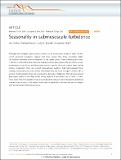Seasonality in submesoscale turbulence
Author(s)
Ferrari, Raffaele; Klymak, Jody M.; Gula, Jonathan; Callies, Joern
DownloadCallies-2015-Seasonality in.pdf (834.7Kb)
PUBLISHER_CC
Publisher with Creative Commons License
Creative Commons Attribution
Terms of use
Metadata
Show full item recordAbstract
Although the strongest ocean surface currents occur at horizontal scales of order 100 km, recent numerical simulations suggest that flows smaller than these mesoscale eddies can achieve important vertical transports in the upper ocean. These submesoscale flows, 1–100 km in horizontal extent, take heat and atmospheric gases down into the interior ocean, accelerating air–sea fluxes, and bring deep nutrients up into the sunlit surface layer, fueling primary production. Here we present observational evidence that submesoscale flows undergo a seasonal cycle in the surface mixed layer: they are much stronger in winter than in summer. Submesoscale flows are energized by baroclinic instabilities that develop around geostrophic eddies in the deep winter mixed layer at a horizontal scale of order 1–10 km. Flows larger than this instability scale are energized by turbulent scale interactions. Enhanced submesoscale activity in the winter mixed layer is expected to achieve efficient exchanges with the permanent thermocline below.
Date issued
2015-04Department
Joint Program in Oceanography/Applied Ocean Science and Engineering; Massachusetts Institute of Technology. Department of Earth, Atmospheric, and Planetary Sciences; Woods Hole Oceanographic InstitutionJournal
Nature Communications
Publisher
Nature Publishing Group
Citation
Callies, Jorn, Raffaele Ferrari, Jody M. Klymak, and Jonathan Gula. “Seasonality in Submesoscale Turbulence.” Nature Communications 6 (April 21, 2015): 6862. © 2015 Macmillan Publishers Limited
Version: Final published version
ISSN
2041-1723